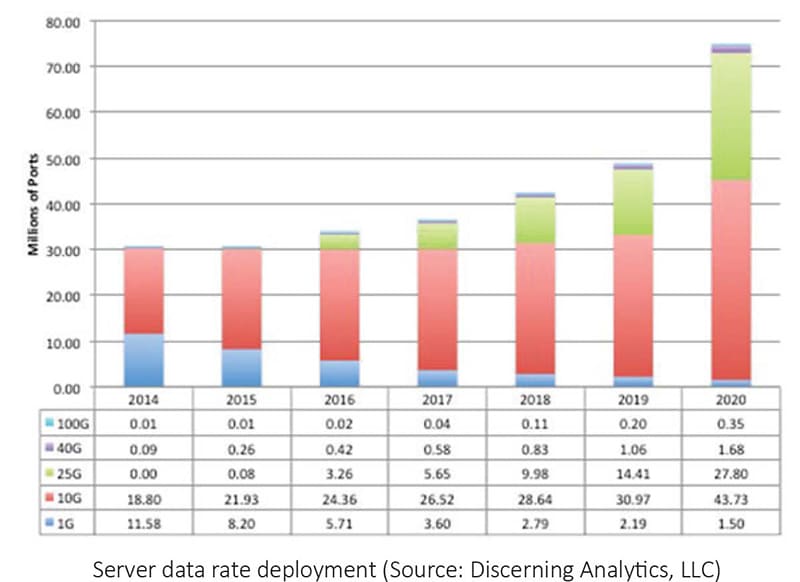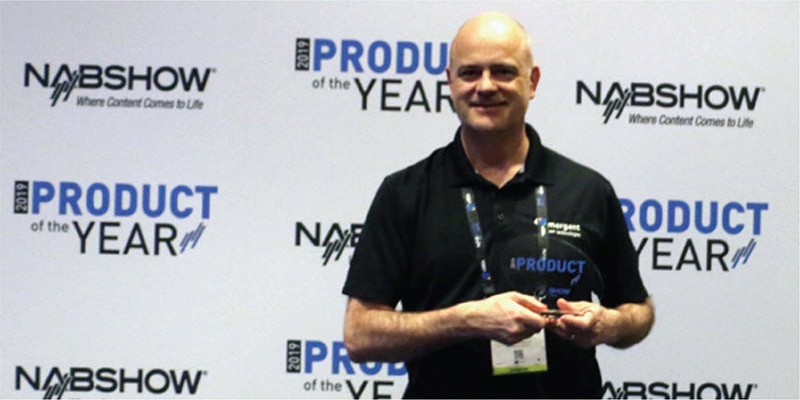White Paper: 50 and 100 GigE FAQs
FAQ’s
Both 50GigE and 100GigE are successors to the highly successful 25GigE technology. Logically, 50GigE is twice the speed of 25GigE and 100GigE is four times the speed of 25GigE. All are managed/produced by the IEEE 802.3 working group.
The standard is used in applications such as telecom, data communications, industrial, military, etc, and now we leverage the benefits of this globally accepted cross-industry technology for machine vision applications.

Yes. GigEVision (the machine vision specific interface standard) regardless of its version supports 50GigE and 100GigE cameras. The later versions add some additional specific elements, which are not critical for the operation of Emergent cameras with various GigE Vision compliant software such as NI Labview, MVTec Halcon, Norpix StreamPix, Matrox MIL, Cognex VisionPro, etc.
The maximum bandwidth available for 50GigE is 50Gbps or 6,250 Mbytes/s and for 100GigE is 100Gbps or 12,500 Mbytes/s, which is the industry’s fastest single link solution.
Absolutely, both 50GigE and 100GigE are considered the new SDI since Broadcast is quickly abandoning the legacy SDI interface for Ethernet based technologies. The streaming technology for Broadcast is SMPTE 2110 and Emergent cameras are a firmware upgrade away from supporting this technology for a seamless drop into a variety of Broadcast applications. SMPTE 2110 and RCP features will be added to Emergent cameras this year.

For 50GigE and 100GigE, the standard defines QSFP28 which is fully compatible with SFP+ and SFP28 in multi-rate switches or other equipment through the use of QSFP28 break-out adapters.
Using the QSFP28 interface provides primarily three options which cover the cable length requirements of all applications. The first and least expensive option is Direct Attach which is a copper based passive solution and the cable lengths for these single piece cables range from 1m to 5m. The second option utilizes QSFP28 multi- mode fiber modules/transceivers and LC-LC multi-mode fiber cables and the cable lengths for this three-piece cable range from 1m to 100m. The third option utilizes QSFP28 single-mode fiber modules/transceivers and LC-LC single-mode fiber cables and the cable lengths for this three-piece cable range from one meter to ten kilometers.
The price range for these cabling options is quite low since they are used across multiple industries in massive volumes unlike for some interface technologies which use cabling options specific to machine vision.

As mentioned, components for 50GigE and 100GigE machine vision applications are used across multiple industries, which allows suppliers of such technologies to deal in volumes, which in turn leads to lower costs. Far more so than machine vision specific interfaces and technologies who also find themselves scrambling around trying to find components to fit the application and when available then sometimes only one or a few providers are in play which allows them to dictate the price.
For the cameras, the price scales with performance. All Emergent camera pricing is always better in price-performance comparisons with Machine Vision specific interfaces such as CoaXPress (CXP).
Power consumption of 50GigE Emergent cameras is around 10W, which is as good or better than a camera of equal performance. At 100GigE, the power rises only to about 12W, which is again as good or better for a camera of equal performance. This power consumption is far less driven by the interface and more-so driven by the FPGA processing required at such high data rates.
When our cameras were first launched 10 years ago, Emergent realized the need for performance receiver technology at the computer and partnered with Mellanox to implement technology with Mellanox’ VMA or Mellanox’ Messaging Accelerator to allow support for 25GigE NICs and higher.
The benefits of such technology are:
- Maximizing camera count per PC
- Extremely low CPU utilization (1% single CPU core overhead for a 9Gbps video stream)
- Minimized System Memory bandwidth
- Extremely low latency
- Extremely low jitter
The first bullet is mainly the result of the 2nd and 3rd points. The software employs DMA or Direct Memory Access from the NIC (network interface card) to system memory without packet headers and thus placing complete video frames into contiguous memory locations without the need for CPU or system memory interaction due to data copies or other NDIS kernel bypass activities.

Limitations that have been reported back to us from our customers about competing 10G camera technology include trouble with dropped packets and frames with even one camera. In addition, some of these competitors have openly confirmed to customers that they have not tested more than two cameras per PC. Many of our customers depend on our reliability to run as many 8-14 cameras per PC. Emergent Vision Technologies has provided dependable, fully functional multicamera systems to our customers for several years now. In addition, more cameras per computer substantially reduces overall system cost.
- Ultra high data/frame rates
- Many accessory and cabling options to cover any length
- Camera network support and accurate multi-camera synchronization methods including PTP support
- Multicast video technology
- Low CPU overhead, low latency, and low jitter
- Highest camera count per PC performance
- Very competitive cost/performance
- Industry acceptance due to IEEE and AIA standardization

Emergent 50GigE and 100GigE cameras, coupled with Mellanox’ VMA, equals or out-performs other interfaces in every technical category and its price performance is the best. With VMA, all the shortcomings associated with 1GigE w.r.t. CPU utilization, latency and jitter are obliterated. Industry acceptance is excellent as well.

Emergent’s solution supports Windows 10 and Ubuntu, RedHat, and CentOS Linux with both our eCapture viewer software and our eSDK.

Yes. Our cameras follow the GigE Vision standard and are thus compatible regardless of Ethernet speed. Highest performance is available when Emergent drivers are used and coupled with Mellanox NICs and 3rd party softwares typically provide the ability to use our low-level driver for frame capture through GenTL technology or other proprietary means.
Cables, switches, network interface cards- to name a few. Many companies have long been on board with industrial modules and chassis blades with QSFP interfaces which lends itself very nicely to a scalable and distributed processing architecture.
The chart below shows very clearly 10GigE and 25GigE adoption for various applications. 100GigE is creeping in and will take more market share as performance demands grow. In machine vision, we are now seeing sensors that justify these datarates for applications like AOI.

PTP methods are commonly used with Emergent cameras. The EVT_PTP eSDK example can be used to kick off your development. With switches and appropriate grandmaster configuration, one can synchronize to sub-microsecond accuracies.
Switches have substantially dropped in price over the past 10 years so one should not be afraid of the cost implications. That said, PTP does not require switches and hardware grandmasters if synchronization accuracy requirement is not in the 10s of micro-second range.
In addition, Emergent offers the standard GPIO accessory options to allow the user to trigger the cameras via external hardware triggering through some user provided hardware signal and do so to sub-microsecond accuracies.

The EVT_Mcast/EVT_Mcast_Master and EVT_Mcast/EVT_Mcast_Slave eSDK examples can be used to kick off your development.
In general, the video from one camera can be sent through a medium-cost switch to multiple receivers. The receivers would typically do the following in these type of applications: they might just receive and display the video for monitoring purposes, they might process the data to allow for a distributed processing architecture, they might save image files to RAID storage, or perhaps they may do all of these things with suitable server performance.
One computer is typically the multicast master so you would run a form of EVT_ Mcast_Master there. This application controls the camera(s) and optionally receives the video data. One or many other computers would run a form of EVT_Mcast_Slave which would receive and process the video data.
Generally, any GigEVision compatible software should work with Emergent cameras by virtue of Emergent cameras being certified as GigEVision compliant by the AIA. We have tested with a many 3rd party softwares such as NI Vision Acquisition Toolbox, MVTec Halcon, Norpix StreamPix 6, Matrox MIL, Cognex VisionPro, etc. Emergent also offers free software with a camera purchase: eCapture is our free viewer software, and eSDK is our C++ SDK for easy high-performance application development.

Standard computers that have an available PCIe x8 or x16 slot will support the Mellanox NICs in a variety of operating systems. Very simple and inexpensive mini- desktops by Asus have an available x16 PCIe slot and can be used for development. Compact expansion chassis such as Sonnettech Echo Express SE III can be used to hold the NICs and link back to a laptop via Thunderbolt 3.
High camera count applications would typically employ Dell, Supermicro or Asus systems with many available PCIe slots.
The final system would only depend on how much image processing is required and at what data/frame rate. For processor intensive applications, GPU/Video cards by NVidia running CUDA or 3rd party FPGA cards can be employed. Since the data arriving from the Mellanox NICs comes with extremely low overhead this allows the system to easily transfer this data to a GPU for further processing.
In conclusion, with Emergent camera and host technology, we give you the best chance for success for your application.
10 years ago, Emergent premiered the world’s first Area Scan 10GigE cameras and since then has been considered the pioneer of ultra-high-speed Ethernet cameras. 4 years ago, Emergent launched the world’s first 25GigE Area Scan cameras and the world’s first 10GigE and 25GigE Line Scan cameras. This has been recognized by Vision Systems Magazine with Gold and Platinum Innovators Awards as well as by the NABSHOW with 2019 Product of the Year award in the Camera category.

Now, 10 years later, competing camera companies are seeing the need for high speed Ethernet camera technology. Some have attempted to launch their own 10GigE cameras, but they have struggled with performance issues thus bringing many of their customers to us. Our many years of experience with the technology is unmatched in the industry. Our products are very mature and reliable which saves customer time and money integrating this high-speed technology.
Meanwhile Emergent introduces another breakthrough in high speed camera technology with the Xtreme 50GigE and Zenith 100GigE cameras.

Emergent provides all the fundamental accessories required to develop your system and application.
We provide all QSFP28 cabling options you may need such as Direct Attach cables or Optical transceivers and LC-LC fiber cable for both multi-mode and single-mode applications. Single mode fiber is generally for long distance applications beyond 100m so please contact Emergent with your requirements.
We provide single and dual port 50G and 100G Network Interface cards from our partner Mellanox.
Lastly, we provide GPIO and power supply options to complete your integration needs.
We are a one-stop shop for your 50GigE and 100GigE machine vision application needs.

Emergent has frame rate calculator tools available on our website: https://emergentvisiontec.com/resources/




